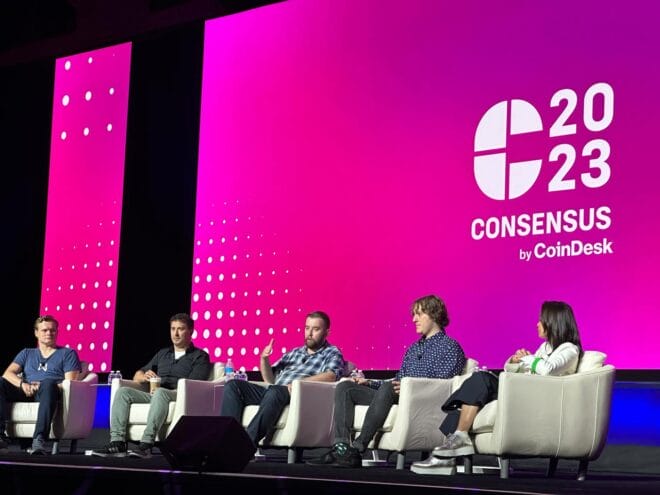During Consensus 2023, Chainlink co-founder Sergey Nazarov joined Polkadot co-founder Robert Habermeier, Ava Labs CEO Emin Gün Sirer, and NEAR Protocol co-founder Illia Polosukhin for a panel discussion, moderated by Forkast Labs Editor-in-Chief Angie Lau, about how to build the future of web3 in any and every market.
Speaking from nearly a decade of experience building web3, Nazarov emphasized that even during times when less “speculative fervor” leads to lower demand and more selective funding, developer adoption continues to rise. “I would like to think that’s because of the clear value our industry provides,” he said.
As Gün Sirer put it, less fervor leads to “times of clarity.”
“This is the time to say, ‘Okay, what did we learn?,’” he said. “We won’t be able to make the transition to the next stage until we realize this is what worked and this is what didn’t.”
From Polosukhin’s point of view, what makes today’s environment especially promising is the degree to which decentralized infrastructure has evolved to support critical use cases.
“For the first time, we do have the technology, we do have the infrastructure, we do have developers, and it’s time to do the things we promised,” he said. He emphasized that demand for real-world use cases persists; the current challenge is abstracting away the multi-chain ecosystem’s complexity to create simple, uniform, intuitive user experiences.
Gün Sirer agreed. “99.99% of people do not care which blockchain things are running on; they just want things to work,” he said. He believes now is the time for web3 to move beyond the developer’s mindset, recruit entrepreneurs to bring use cases to market, and “show the world how normal people can interact with blockchains.”
“It’s very important to get outside of the crypto developer bubble,” Habermeier agreed. His goal for the industry is to find ways to deliver its core values of “transparency, reliability, open-source software, and decentralized trust” into applications “that can reach everyday people.”
Beyond DeFi, the panelists pointed to blockchain-based gaming and tokenized real-world assets as two of the biggest areas ripe for innovation. “Asset tokenization will be a big deal,” Nazarov explained, because it can drive both real-world and virtual markets.
“We need to think a lot more about that state of the world where people are building applications which are not blockchain applications,” Polosukhin added. “They’re just using blockchain to enable various new experiences and create this trustless and user-owned environment.”
Habermeier pointed to a less excited market as the perfect opportunity to spend time innovating better solutions instead of applying “copy and paste” to what already exists. “A lot of this stuff is difficult to do – you have to wander around in idea mazes until you discover something that’s truly original and truly foundational for a new type of use case,” he explained.
Ultimately, Gün Sirer advised, no matter the market conditions, the “curve of adoption” is what truly matters. “It’s up and to the right and it cannot be stopped,” he said.
“Markets are statements of position as opposed to statements of velocity,” Habermeier agreed. “What’s much more important for building is where are things going rather than where are things now.”


